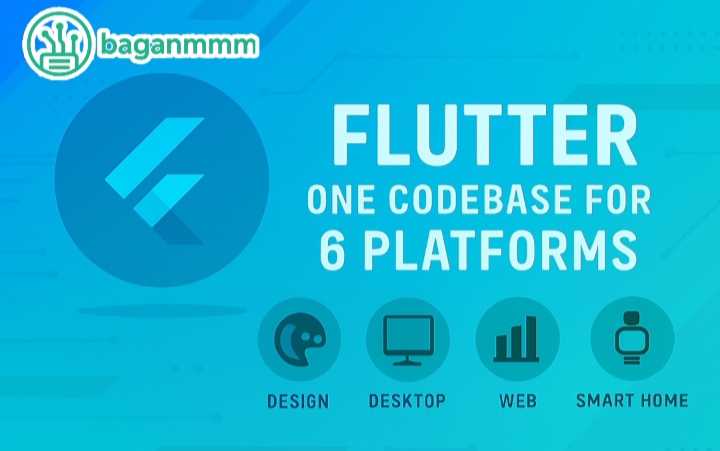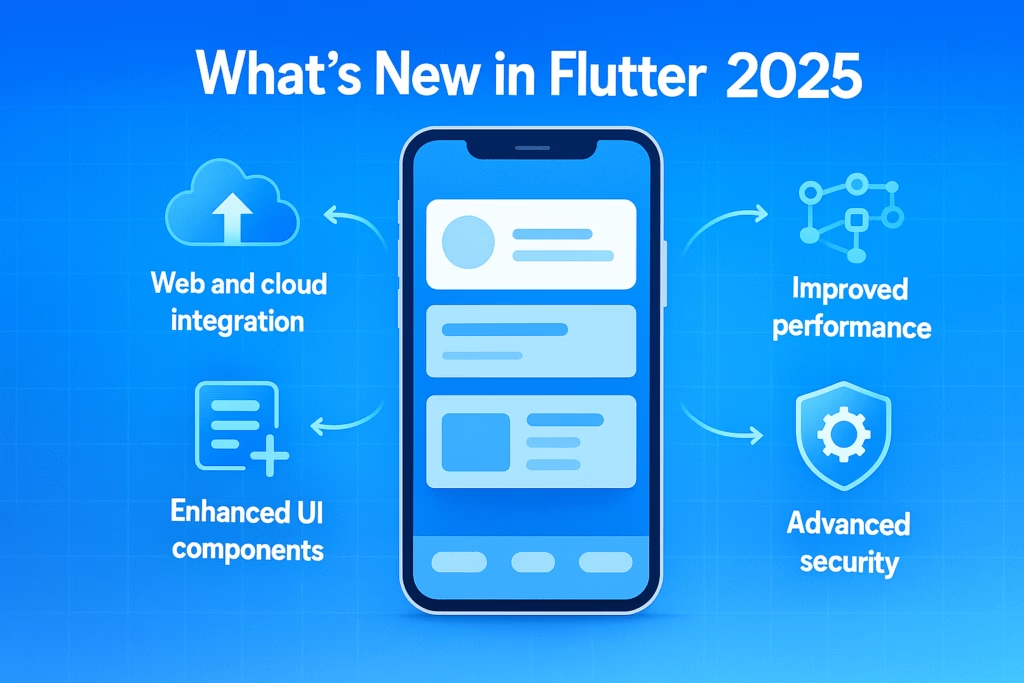This time, I would like to introduce a framework that beginners in programming or junior‑level developers should learn. That is the Flutter framework, an all‑in‑one platform framework created by Google. Flutter was first introduced by Google in 2015. Its main language is Dart , which was also developed by Google. Dart is a high‑level language similar to C# and Java, making it easy to learn. And since it is developed by a tech giant like Google, you can trust its community support and long‑term development.

Therefore, Flutter is a framework that juniors and first‑time learners should definitely choose. Its main advantage is the “one codebase for all platforms” approach with a single codebase, you can run apps on web, Android, iOS, and desktop. Other frameworks don’t provide this level of cross‑platform support. For example, Laravel is limited to web only, while frameworks like React or Node are mainly for Android and web. Flutter, however, covers them all.
Another advantage is faster development time. Thanks to the hot reload system, you can instantly test UI changes as soon as you edit the code. Flutter also provides a wide variety of widgets and UI components, created by Google and the developer community, which are easy to use. On top of that, in today’s job market, the demand for Flutter developers is very high.
For these reasons, Flutter is a framework worth choosing. This blog explains Flutter and highlights its advantages.
What Is Flutter?
Flutter is a UI toolkit that allows developers to build apps for Android, iOS, Web, and Desktop all from a single codebase. This is Flutter’s unique capability. No other framework so far has been able to create true cross‑platform apps with just one codebase like Flutter.
Flutter is built with the Dart programming language, which was created by Google. Dart is similar to Java and C++, but since it is a high‑level programming language, it is relatively easy to learn.
Flutter was first introduced by Google in 2017, and Flutter 1.0 was officially released in December 2018.
Key Advantages
Cross‑platform
- With a single codebase, you can build apps for Android, iOS, Web, and Desktop.
- This is a truly remarkable innovation.
- It speeds up development time for developers and provides a consistent UI across platforms, which is impressive.
High Performance
- Flutter is natively compiled, making it fast and smooth.
- Since Dart, Flutter’s main language, is influenced by Java and C++, it can achieve near‑native performance.
Widgets‑based
- Flutter apps are built using widgets, which makes the UI highly customizable.
- In other words, each UI element is a widget that can be freely modified.
- From a design perspective, it’s like having neatly separated layers.
Hot Reload
- Developers can instantly see UI changes when they edit code.
- This greatly speeds up development and is one of the most loved features.
Strong Ecosystem
- A wide range of plugins, packages, and strong community support are available.
- Since it is backed by Google, the ecosystem is robust and reliable.
This is a brief overview of Flutter. Next, let’s explore what new features Flutter has added in 2025.

What’s New in Flutter 2025
Since its initial release, Flutter has gradually advanced, and for the year 2025, it is introducing powerful new upgrades for faster and more efficient, scalable development. This movement is a truly brilliant transformation. These changes are a key factor that allows it to outperform other frameworks.
Let’s take a look at the distinctive changes in Flutter for 2025.
Dart 4 Language Update
- Improved Concurrency with Isolate Pools: Concurrency is better with Isolate Pools.
- Cleaner Syntax using Records and Patterns: The syntax is cleaner by using Records and Patterns.
- Reduced Boilerplate Code with Smarter Type Inference: Boilerplate code is reduced with smarter type inference.
These changes make Dart’s performance better and allow for efficient app building with less code. The advantage is that code complexity is reduced, and code quality is enhanced.
Impeller 2.0 Rendering Engine
- Replaced Skia and Used as Default Renderer: It has replaced Skia and is used as the default renderer. This change provides smoother support for 120Hz animations, making it more suitable for game animation.
- Significant Performance Change: It supports custom shaders and GPU acceleration, leading to a noticeable change in performance.
- Improved Frame Stability: Frame stability is improved across all platforms, reducing jank.
This is a noticeable change for cross-platform development.
AI-Assisted DevTools
In line with the AI era, it can now provide real-time suggestions for Widget structure and state management.
- Smart Debugging: It provides smart debugging with predictive error detection.
- Faster Development Time: It can auto-generate boilerplate code for Models, navigation, and animations, speeding up development time.
These features make Flutter the best choice for rapid prototyping and MVP development. MVP has been a main feature of Flutter since its beginning and is a factor that makes it superior to other frameworks.
Unified Widget Rendering
- Consistent Behavior: It provides consistent behavior for both Mobile and Web.
- Improved Design Fidelity: The shared rendering logic enhances design fidelity.
- Faster Development: Cross-platform UIs can be maintained and tested more efficiently, leading to faster development time.
In summary, due to Dart 4, Impeller 2.0, AI DevTools, and Unified Rendering, Flutter 2025 has advanced to become a faster and more effective framework for developers. This is a change that every Flutter Developer has been waiting for. These changes are what make Flutter superior to other frameworks.
These are the changes for Flutter in 2025. Next, I will discuss why Flutter is the cross-platform framework you should choose in 2025.
Why Flutter Is Still #1 in 2025
According to developer surveys for the year 2025, Flutter remains the most popular Cross-Platform Framework among developers. It is especially the favorite framework for developers in the mobile development sector. The ability to release an app for both Android and iOS with just one codebase is a factor that keeps it a step ahead of other frameworks.
These capabilities lead to faster development time and unified UIs.
Reasons Why Flutter is the Most Popular Cross-Platform Framework
1. Faster Development Time
- The upgraded Hot Reload allows for much faster testing of UI changes.
- It includes Built-in Testing and Debugging Tools.
- It has a Rich Widget Library for native-like UI.
These are advantages that satisfy every developer.
2. One Code to 6 Platforms
- The ability to use only one codebase for six platforms is a unique feature that no other framework has yet provided.
- Flutter can effectively support applications ranging from small-scale projects to Enterprise-level apps.
- Top companies like Google Ads, BMW, eBay Motors, Groupon, and Alibaba are using it, which proves that Flutter’s capability and Ecosystem are excellent.
3. UI Customization
- Flutter’s Widget system allows for the creation of Pixel-Perfect designs. The ability to create a UI as a single widget allows for free and independent creation without clashing with other UIs.
- It supports Material Design and Cupertino Widgets. Google’s Material Design is becoming popular in the UI world.
- The advantages of Impeller 2.0 satisfy developers.
4. Business Value
- Faster time-to-market (getting to the market faster).
- Lower development and maintenance costs.
- It has a Scalable Architecture for enterprise-level apps.
These are the advantages that make Flutter appealing to developers. The ability to support certain features that are not yet available in other frameworks is a unique characteristic of Flutter.
Next, I will continue to present information about Flutter’s ecosystem.
Flutter Ecosystem in 2025
The fact that Flutter is “One code to 6 platforms” means it should be considered more than just a Framework. Moreover, due to the noticeable changes in 2025, Flutter has become a Development Platform. Therefore, Flutter possesses an ecosystem that goes beyond that of ordinary frameworks.
Flutter’s Ecosystem
- Flutter DevTools: Performance profiling, debugging, and AI assistance.
- Riverpod & Bloc: Solutions for State Management.
- Go_router: Simplified Navigation system.
- Flutter Web & Desktop: Now fully production-ready for Admin Panels and Enterprise Tools.
- Flock: A community-led fork focused on faster builds and lighter SDKs.
These are the ecosystem changes for Flutter in 2025. The inclusion of AI tools makes it a complete Development Platform, not just an ordinary framework.
Flutter in the Job Market
Flutter developers remain in high demand across various industries. Because Flutter is “one code base to 6 platforms,” the cost of app development is significantly reduced, leading industries across the board to choose Flutter developers. Furthermore, because the development time is very fast, software industries are increasingly hiring Flutter developers.
Industries with the Highest Demand for Flutter Developers, according to 2025 Surveys
* Fintech (Financial Technology): Primarily needed because it is secure and the UI is consistent across all platforms.
- E-commerce Sector: Usage is increasing due to its strong performance and advantage in UI customization.
- Government & Enterprise: It is more useful for large organizations because the “one to 6 platforms” capability allows for easy extension (scaling).
- Startups: It is being used more frequently by small businesses because the development time is fast and the financial cost is low.
According to recent surveys, Flutter developers have increased to 46% as of 2023. Additionally, as junior developers prioritize learning Flutter, the number of Flutter developers is increasing every year. On the other hand, due to the increasing demand from business industries, the Flutter job market is gradually growing.
This information on Flutter’s job market status is based on global surveys. Next, I will discuss the distinctive changes for Flutter in 2025.
Special Features of Flutter
1. Single Codebase for 6 Platforms
Why it matters: Flutter lets developers build apps for iOS, Android, Web, Windows, macOS, and Linux all from one Dart codebase.
Impact on competitors:
- React Native still struggles with full desktop support
- Xamarin requires platform-specific tweaks
- Native development demands separate teams for each OS
Flutter’s unified approach slashes development time and cost by up to 30%, giving startups and lean teams a major edge.
2. Impeller 2.0 Rendering Engine
Why it matters: Flutter’s new Impeller engine replaces Skia, delivering 120Hz animations, GPU acceleration, and custom shader support.
Impact on competitors:
- React Native relies on native views and can suffer from jank
- Web-based frameworks struggle with fluidity on mobile
Flutter now rivals native performance without native complexity.
3. Hot Reload & AI-Assisted DevTools
Why it matters: Flutter’s legendary Hot Reload lets developers see code changes instantly. In 2025, it’s enhanced with AI-powered suggestions, predictive debugging, and auto-scaffolding.
Impact on competitors:
- Speeds up iteration cycles dramatically
- Reduces onboarding time for new developers
- Makes Flutter ideal for MVPs and rapid prototyping
4. Rich Widget Library & Custom UI
Why it matters: Flutter uses its own rendering engine and widget system not native components allowing pixel-perfect design across platforms.
Impact on competitors:
- React Native depends on native UI, which varies by OS
- Flutter ensures consistent look and feel everywhere
- Designers love Flutter for its flexibility and control
5. WebAssembly Support for Flutter Web
Why it matters: Flutter Web now supports Wasm (WebAssembly), delivering near-native performance in browsers.
Impact on competitors:
- React and Angular still rely on JavaScript runtime
- Flutter Web apps load faster and run smoother
This positions Flutter as a serious contender in web-first development
6. AI-Ready Architecture
Why it matters: Flutter’s Dart 4 and service architecture make it easy to integrate AI APIs, chatbots, and LLMs.
Impact on competitors:
- Flutter apps can run AI features locally or via cloud
- Ideal for building smart assistants, recommendation engines, and real-time analytics
- Developers can plug into OpenAI, Gemini, or custom models with minimal friction
7. Accessibility & Inclusive Design
Why it matters: Flutter 2025 expands accessibility support across mobile and web including screen readers, semantic widgets, and adaptive layouts.
Impact on competitors:
- Many frameworks treat accessibility as an afterthought
- Flutter’s inclusive design tools help meet global compliance standards
- Crucial for government, education, and enterprise apps.
Final Thought
By now, we have covered enough about Flutter. Flutter is more than just an ordinary framework it is a framework that has created a major shift in the cross‑platform development world. Because it supports the Skia rendering engine, it delivers fast performance and near‑native quality.
On Android, developers can access features like camera, Bluetooth, and GPS, and for other platform‑specific needs, Flutter can also integrate with native languages such as Swift, Kotlin, and Java.
According to the 2025 job market demand, Flutter is one of the frameworks worth learning. Within a short time, it has built a large community, which makes it a promising framework with the potential to lead the industry.
If you are interested in Flutter, you can find the necessary documentation, tutorials, and UI kits at flutter.dev.
This blog is created purely for educational, informational purposes and not promotional.
Alice is the visionary behind Baganmmm Tech, a platform he founded with a passion for demystifying the complex world of technology. As the Lead Technologist, he's often found in his home lab – a cozy, wire-filled sanctuary where ideas are born and code is meticulously crafted. His infectious enthusiasm and knack for explaining intricate concepts make him the go-to expert for everything from web development to emerging tech trends.
